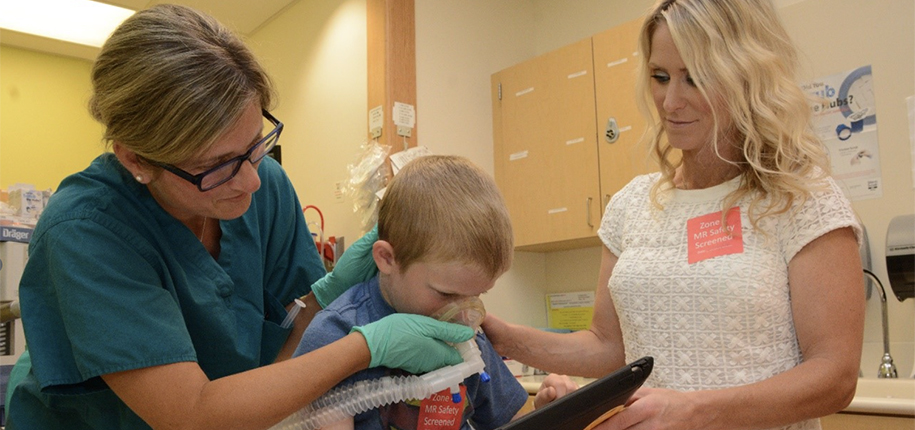
Most imaging studies performed in the Radiology Department require your child to hold still. Some studies, like X-rays, are completed very quickly. Because these studies are like a photograph, most children can hold still long enough to get a good picture. Other studies like CT, nuclear medicine, or MRI take longer. Sometimes these studies even require your child to hold their breath for long periods of time. If your child is unable to hold still for long periods of time, anesthesia may be necessary to complete the exam successfully and safely.
When you call to schedule your child’s Radiology study, our team will ask you a series of questions to help determine if anesthesia is needed. Once your child’s exam is scheduled with anesthesia, a nurse from the Anesthesia Imaging department will contact you around 5 days before the procedure with preparation instructions. It is important to follow these instructions carefully. When you arrive on the day of the imaging study, a nurse or Patient Care assistant will escort you and your child back to a patient prep room. There you will be asked about your child’s medical history including allergies and current medications. Your child’s pulse rate, temperature, and breathing will also be assessed.
When it is time for the exam to begin, the Anesthesia and Imaging teams will gather to perform a “time-out.” This is where everyone involved in your child’s care will meet to confirm the exam. They will state your child’s name, birthdate, medical record number, allergies, weight, and type of exam being performed. The time-out ensures that everyone is on the same page so that we can care for your child as safely as possible.
After the time-out, it is safe to move to anesthesia induction, the stage where your child is placed under anesthesia. In some instances, you may be offered the option of accompanying your child into the exam room for the beginning of the anesthesia induction. In order to make this process as safe as possible, the Anesthesia department has developed guidelines for when parents are not permitted to accompany their child to anesthesia induction. Per these guidelines, parents cannot accompany their child to induction if their child is under 1 year of age, weights under 10 kilograms, has a complex medical history, or is at risk for aspiration. Ultimately, the anesthesiologist will make the final determination if it is appropriate and safe for parents to accompany their child at this stage.
Of course, if this is offered, you are not obligated to be present with your child. We understand that it may be difficult to watch your child at this stage. Please note that parental presence at anesthesia induction is only available in the Radiology department. Due to safety reasons, there are no other departments at Cincinnati Children’s Burnet Campus that offer this involvement. This includes the main operating rooms.
Once your child is brought to the exam room, they will be introduced to the room and some of the equipment they will see. The Anesthesia team will introduce your child to a face mask, which contains anesthetic gases to help them fall asleep and stay asleep during the exam. The gases may be flavored for a more pleasant smell. The Anesthesia team will monitor your child and will determine the point where they start to fall asleep. At that point, your child may not necessarily look asleep, but be assured that they are no longer aware. This is the time when the Anesthesia team will invite you to give your child a quick kiss and a “see you later,” and you will be escorted out of the exam room. This will be a quick transition, as from this point forward the Anesthesia team needs to be entirely focused on the safety and well-being of your child.
You will be directed toward the waiting room during your child’s exam. You may get updates using the CAREN app or the status board in the waiting room. You will be updated when your child is headed to the recovery room and again when your child is ready for visitors.
Recovery is usually rapid with few side effects. Results of the exam will be released to MyChart between the hours of 6am and 6pm.
CAREN app: Meet Caren, the Cincinnati Children’s Digital Concierge App (cincinnatichildrens.org)
MyChart app: MyChart | Information and Link to Sign In (cincinnatichildrens.org)

Jessica is a CT Tech who works primarily at Base and floats to Liberty CT. Her entire professional career of nearly 22 years has been at CCHMC in the Radiology Department. It was during her clinical rotation in x-ray school where she learned of her passion to work with children. In her free time, she and her husband enjoy cooking together and traveling. She has 2 adult stepsons and 2 dogs.
Jessica Neumann, B.S., R.T. (R) (CT), author; Glenn Miñano, BFA, editor; Meredith Towbin, copy editor
Collaboration with Dr. Naina Rao, Anesthesia Imaging Director